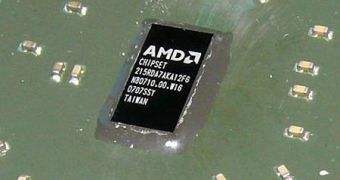Advanced Micro Devices will launch its much awaited RD790 chipset designed for the new generation of central processing units in the last days of September, and two important players on the mainboard market, Asustek and Gigabyte, are very likely to release compliant motherboards immediately after that. The AMD RD790 is intended as a high end chipset to be used with the upcoming Phenom class of processors and the most important mainboard manufacturers and vendors are waiting for it as they listed the new chipset as one of their major interests for the fourth quarter of 2007.
The RD790 will be the center of a new processor socket architecture, the AM2+, and even if the Phenom processors will arrive some time after it, mainboards featuring that AMD chipset will be available in stores as soon as the next month. As the two most important mainboard manufacturers and vendors in the whole world, both Asus and Gigabyte are expected to start production of RD790 centered mainboards in early September, while other producers are likely to delay them for at least another month or so.
The two leading producers already delivered engineering samples, also known as design verification test (DVT for short) samples to AMD validation laboratories in Taipei, and because the new processor socket, the AM2+ and the new chipset, the RD790, will be both backward fully compatible with housing the older AM2 Athlon family of processors, the two leading mainboard manufacturers may find themselves selling their products alongside the single and dual core AMD processors.
According to the news site digitimes which cites the AMD official road map, the CPU manufacturer and vendor will release the RD790 chipset made using the 65nm fabrication process at the Taiwan Semiconductor Manufacturing Company (TSMC for short) in a few weeks and it will represent the company's first attempt at developing a chipset that supports quad graphics solutions as well as the next generation of processors as well as the HyperTransport version 3.0 along side with PCI Express 2.0 and Triple CrossFire support, a multi graphics card setup that will offer support for three cards.

 14 DAY TRIAL //
14 DAY TRIAL //